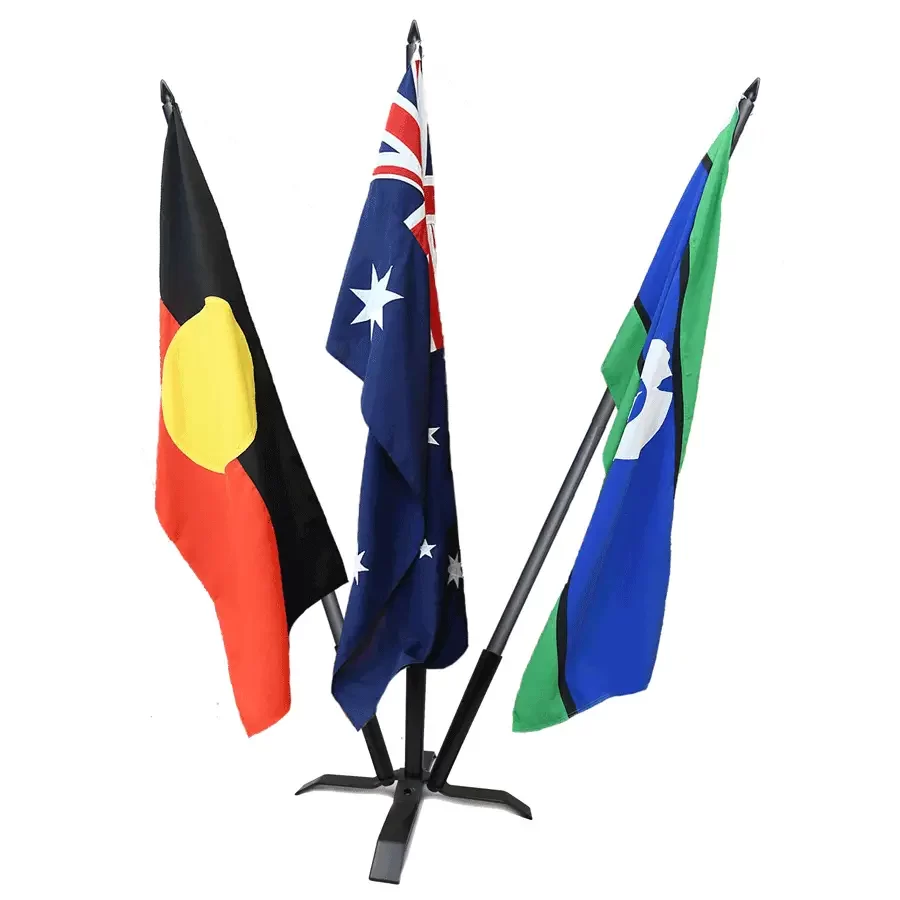South Australia
South Australia (SA) is a state in the southern central part of Australia. It covers some of the aridest parts of the country, with a total land area of 984,321 square kilometres (380,048 sq mi). It is the fourth largest of Australia’s states and territories by area, and the second smallest state by population.
Read more on South Australia https://en.wikipedia.org/wiki/South_Australia
Map of South Australia
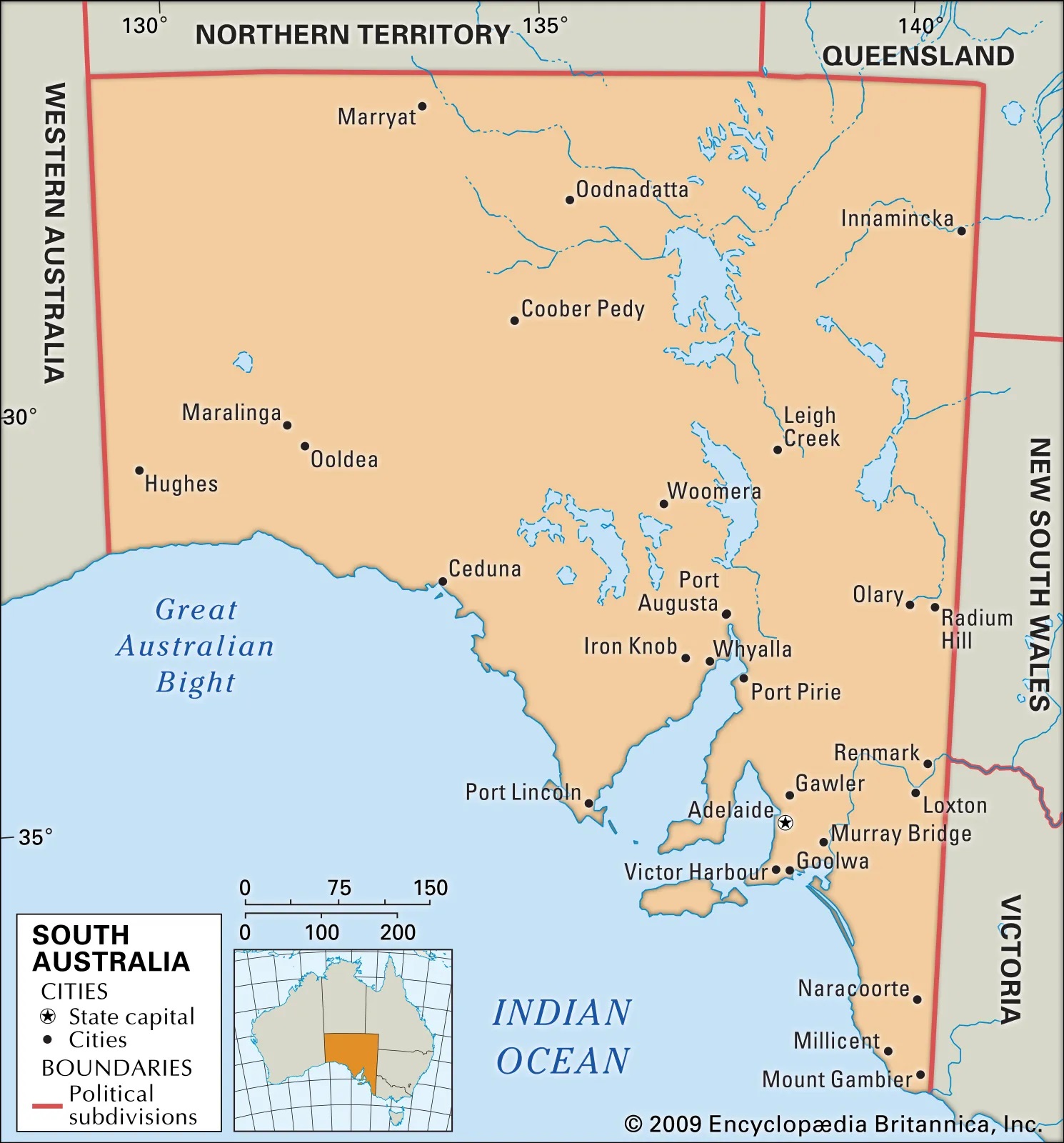
For more on the map of South Australia https://www.britannica.com/place/South-Australia
Coat of Arms for South Australia
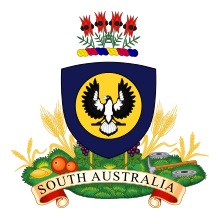 The coat of arms of South Australia is the official symbol of the state of South Australia. It was granted by Queen Elizabeth II on 19 April 1984. They replaced a coat of arms granted to the State in 1936 by King Edward VIII.
The coat of arms of South Australia is the official symbol of the state of South Australia. It was granted by Queen Elizabeth II on 19 April 1984. They replaced a coat of arms granted to the State in 1936 by King Edward VIII.
For more on South Australia’s Coat of Arms https://en.wikipedia.org/wiki/Coat_of_arms_of_South_Australia
Flag for South Australia
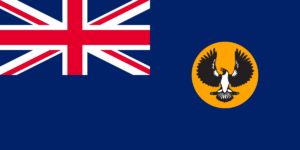 The current state flag of South Australia was officially adopted by the government of South Australia in 1904.
The current state flag of South Australia was officially adopted by the government of South Australia in 1904.
The flag is based on the defaced British Blue Ensign with the state badge located on the fly. The badge is a gold disc featuring a piping shrike with its wings outstretched. The badge is believed to have been originally designed by Robert Craig, a teacher at the School of Arts in Adelaide, and officially gazetted on 14 January 1904.
For more on South Australia’s Flag https://en.wikipedia.org/wiki/Flag_of_South_Australia
Emblems of South Australia
Animal Emblem
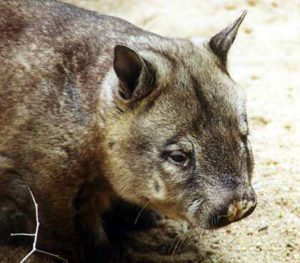 The southern hairy-nosed wombat is one of three extant species of wombats. It is found in scattered areas of semiarid scrub and Mallee from the eastern Nullarbor Plain to the New South Wales border area. It is the smallest of all three wombat species. The young often do not survive dry seasons. It is the state animal of South Australia.
The southern hairy-nosed wombat is one of three extant species of wombats. It is found in scattered areas of semiarid scrub and Mallee from the eastern Nullarbor Plain to the New South Wales border area. It is the smallest of all three wombat species. The young often do not survive dry seasons. It is the state animal of South Australia.
Bird Emblem
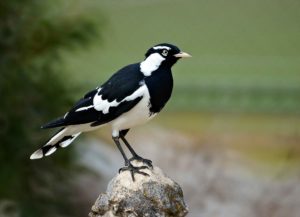 The White-backed Magpie or the Piping Shrike has never been proclaimed as the South Australian Bird Emblem, but is a Symbol of South Australia and can be found in just about every backyard, park and street in that state.
The White-backed Magpie or the Piping Shrike has never been proclaimed as the South Australian Bird Emblem, but is a Symbol of South Australia and can be found in just about every backyard, park and street in that state.
Floral Emblem
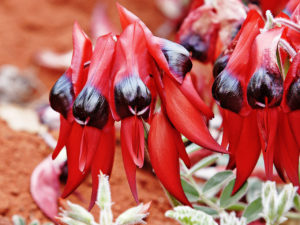 Sturt’s desert pea is an Australian plant in the genus Swainsona, named after English botanist Isaac Swainson, famous for its distinctive blood-red leaf-like flowers, each with a bulbous black centre, or “boss”. It is one of Australia’s best-known wildflowers. It is native to the arid regions of central and north-western Australia, and its range extends into all mainland Australian states except Victoria.
Sturt’s desert pea is an Australian plant in the genus Swainsona, named after English botanist Isaac Swainson, famous for its distinctive blood-red leaf-like flowers, each with a bulbous black centre, or “boss”. It is one of Australia’s best-known wildflowers. It is native to the arid regions of central and north-western Australia, and its range extends into all mainland Australian states except Victoria.
Fish Emblem
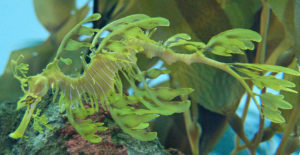 The leafy seadragon (Phycodurus eques) or Glauert’s seadragon is the only member of the genus Phycodurus and is a marine fish in the family Syngnathidae, which includes seadragons, pipefish, and seahorses. It is found along the southern and western coasts of Australia.
The leafy seadragon (Phycodurus eques) or Glauert’s seadragon is the only member of the genus Phycodurus and is a marine fish in the family Syngnathidae, which includes seadragons, pipefish, and seahorses. It is found along the southern and western coasts of Australia.
Gemstone Emblem
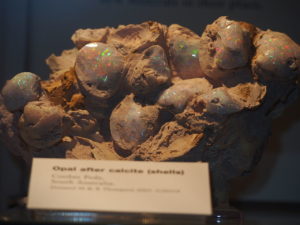 Opal is a hydrated amorphous form of silica (SiO2·nH2O); its water content may range from 3 to 21% by weight but is usually between 6 and 10%. Because of its amorphous character, it is classed as a mineraloid, unlike crystalline forms of silica, which are classed as minerals. It is deposited at a relatively low temperature and may occur in the fissures of almost any kind of rock, being most commonly found with limonite, sandstone, rhyolite, marl, and basalt.
Opal is a hydrated amorphous form of silica (SiO2·nH2O); its water content may range from 3 to 21% by weight but is usually between 6 and 10%. Because of its amorphous character, it is classed as a mineraloid, unlike crystalline forms of silica, which are classed as minerals. It is deposited at a relatively low temperature and may occur in the fissures of almost any kind of rock, being most commonly found with limonite, sandstone, rhyolite, marl, and basalt.
Mineral Emblem
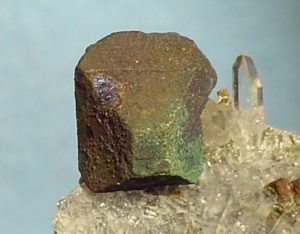 Bornite, also known as peacock ore, is a sulphide mineral with the chemical composition Cu5FeS4 that crystallises in the orthorhombic system. Bornite has a brown to copper-red colour on fresh surfaces that tarnishes to various iridescent shades of blue to purple in places. Its striking iridescence gives it the nickname peacock copper or peacock ore.
Bornite, also known as peacock ore, is a sulphide mineral with the chemical composition Cu5FeS4 that crystallises in the orthorhombic system. Bornite has a brown to copper-red colour on fresh surfaces that tarnishes to various iridescent shades of blue to purple in places. Its striking iridescence gives it the nickname peacock copper or peacock ore.
Fossil Emblem
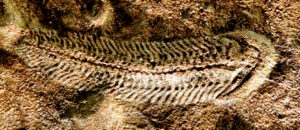 Spriggina is a genus of early bilaterian animals whose relationship to living animals is unclear. Fossils of Spriggina are known from the late Ediacaran period in what is now South Australia.
Spriggina is a genus of early bilaterian animals whose relationship to living animals is unclear. Fossils of Spriggina are known from the late Ediacaran period in what is now South Australia.
For more on South Australia’s Emblems https://en.wikipedia.org/wiki/Symbols_of_South_Australia
Colour Emblem
Dark Blue, Red and Gold Dark Blue-Pantone 295, Red-Pantone 199 & Gold-Pantone 137
For more on the Colour Emblems https://en.wikipedia.org/wiki/Australian_state_and_territory_colours
Island Governed by South Australia
Kangaroo Island
-
-
- Location: Southern Ocean, 112 km southwest of Adelaide, South Australia
- Population: ~4,700
- Governed by: South Australia (Kangaroo Island Council)
-
Kangaroo Island (often shortened to KI) is Australia’s third-largest island—after Tasmania and Melville Island—and one of the country’s top eco-tourism destinations. Known for its abundant wildlife, stunning coastal scenery, and pristine national parks, Kangaroo Island is often called “Australia’s Galápagos” for its rich biodiversity and isolation.
Despite suffering significant damage during the 2019–20 bushfires, KI has bounced back with renewed conservation efforts and community spirit, welcoming travellers eager to explore its unspoiled landscapes and vibrant food scene.
Highlights:
-
-
- Flinders Chase National Park:
Home to the iconic Remarkable Rocks, Admirals Arch, and rugged cliffs teeming with seals, this park is a must-see for anyone visiting KI. - Seal Bay Conservation Park:
Walk among a colony of endangered Australian sea lions with a guided tour or boardwalk view. - Wildlife Encounters:
KI is famous for its wild kangaroos, koalas, echidnas, wallabies, and over 260 bird species. Many animals here evolved without mainland predators. - Beaches and Coastal Beauty:
Swim or relax at stunning spots like Vivonne Bay, Stokes Bay, and Emu Bay, which offer white sands, turquoise waters, and safe swimming. - Food and Wine:
KI is a gourmet hub, producing organic honey, fresh oysters, artisan cheeses, premium wines, and craft gin. Don’t miss a visit to Clifford’s Honey Farm, Island Beehive, or KI Spirits distillery. - Scenic Drives and Walks:
The island offers incredible road trips and bushwalks through woodlands, coastal cliffs, and farmland. Cape Willoughby Lighthouse provides dramatic coastal views and maritime history.
- Flinders Chase National Park:
-
Conservation & Recovery:
Kangaroo Island faced devastation during the 2019–20 bushfires, with over 40% of the island affected. In the years since, there’s been a strong push for ecological restoration, with new growth visible across parks and reserves. Tourism here actively supports conservation, and many experiences focus on sustainable travel.
Getting There:
-
-
- By air:
Flights operate from Adelaide to Kingscote Airport (approx. 30 minutes). - By sea:
SeaLink ferry runs between Cape Jervis (south of Adelaide) and Penneshaw on the island (approx. 45 minutes). Vehicles and foot passengers are welcome.
- By air:
-
Why Visit Kangaroo Island?
Kangaroo Island is a nature lover’s paradise. Whether you’re spotting sea lions on the beach, sampling honey from the world’s purest Ligurian bees, hiking past ancient granite boulders, or sipping local gin as the sun sets over the ocean, KI offers a wild, authentic Australian experience just a short hop from the mainland.
